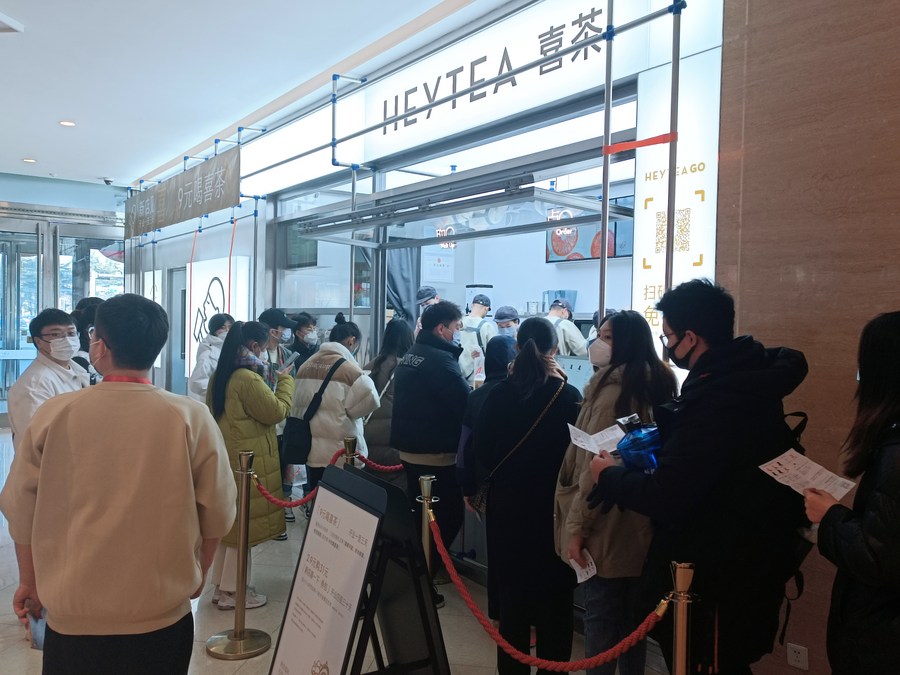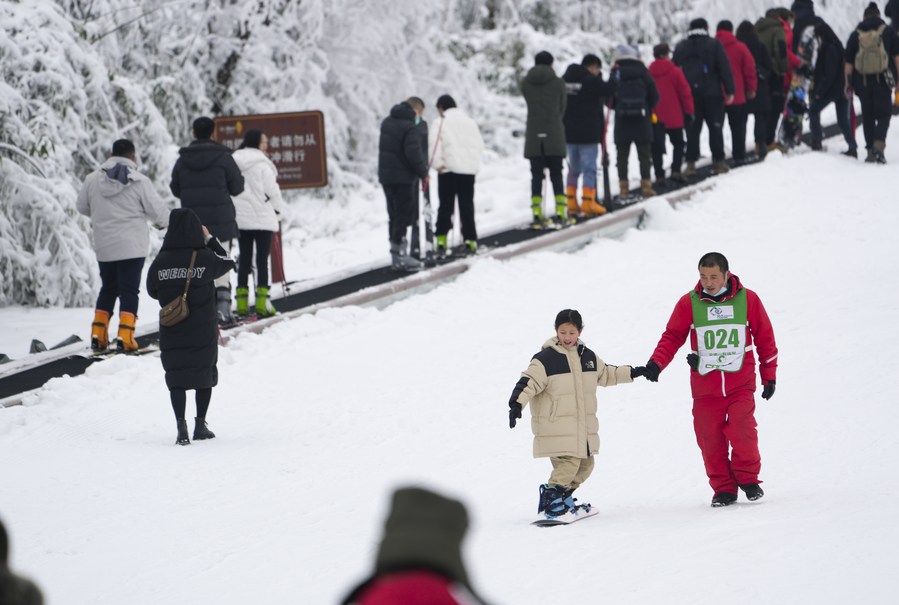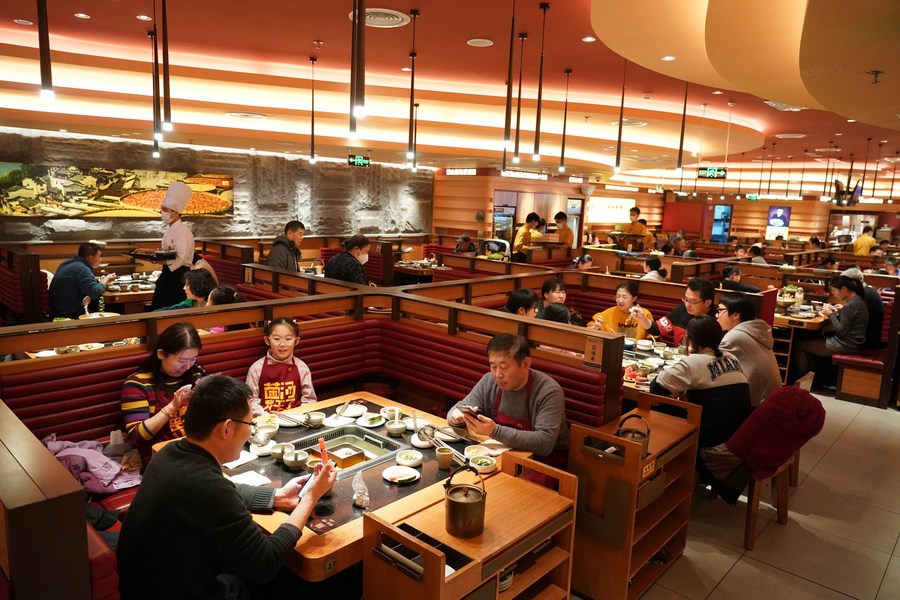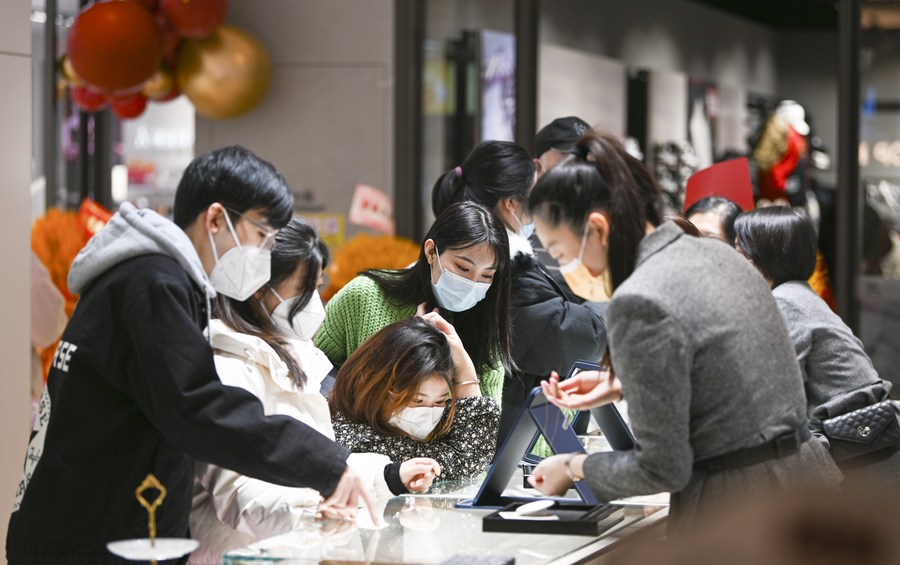SHIJIAZHUANG, Jan. 10 (Xinhua) — Though the Spring Festival is still a few days away, shopping malls in the city of Baoding, north China’s Hebei Province, are already preparing for the most important Chinese holiday of the year. Right now red Chinese knots and the festival’s mascot can be seen all over Baoding.
With continuously optimized COVID-19 prevention and control policies, Baoding, a city with a population of about 10 million, has gradually recovered from the negative impact of the epidemic, regaining its hustle and bustle, which is an epitome of Chinese cities.

People visit a shopping complex in Guangzhou, south China’s Guangdong Province, Jan. 1, 2023. (Xinhua/Liu Dawei)
SHOPPING
Shopping malls have been the first to scent the recovery and the huge business opportunities that come with it.
A monitoring system developed by Baidu Maps has shown that the congestion index of shopping malls in cities like Chongqing, Xi’an, Beijing, and Shenzhen had increased significantly on Jan. 1.
According to the Consumer Market Big Data Laboratory (Shanghai), Shanghai’s total offline consumption hit 12.01 billion yuan (about 1.77 billion U.S. dollars) from Dec. 31, 2022, to Jan. 1, 2023.
Businesses in many cities have issued consumption coupons to attract shoppers. In late December, Hohhot in north China’s Inner Mongolia Autonomous Region issued vouchers worth a total of 38 million yuan, covering consumption in sectors such as retail, catering, home appliances, automobiles, and e-commerce.
The Baoding government has provided 100 million yuan of financial support through the purchase of services, enabling the city and its counties to jointly issue electronic consumption coupons to further stimulate their consumption potential.

This photo taken on Dec. 31, 2022 shows people taking part in an event to celebrate the New Year at a shopping mall in Baoding, north China’s Hebei Province. (Xinhua)
“We hosted a New Year’s Eve party on Dec. 31 last year, and 160,000 people attended the event that night, which was totally beyond our expectations,” said Zhao Yaxin, deputy director of investment promotion at Wanbo Plaza (Baoding).
At a milk tea shop on the first floor of the plaza, queuing customers crowd the 15-square-meter store. It takes 15 minutes for a customer to get their tea after ordering.
“On Christmas Day last year, the average daily customer flow was 60,000, returning to the level seen in 2019. There will be more visitors during the upcoming Spring Festival holiday,” Zhao said.
“In fact, the main purpose of large-scale activities in shopping malls is not marketing, but to let people get out of their homes and improve urban vitality, which is very important for a city,” Zhao said.

People queue up to buy drinks at a shopping mall in Baoding City, north China’s Hebei Province, on Dec. 31, 2022. (Xinhua)
TOURISM
As society is reinvigorated, so is the tourism market. Consumers are leaving their homes to visit tourist attractions.
China recorded roughly 52.7 million domestic tourist visits during the three-day New Year holiday, up 0.44 percent year on year, according to the Ministry of Culture and Tourism.
The tourism revenue generated over the holiday reached over 26.5 billion yuan, up 4 percent from the same period last year, according to the ministry.
Popular travel destinations like the southern coastal resort city of Sanya or Zhangjiakou in the cold north — where snow and ice sports flourish — welcomed an influx of tourists during the holiday, with many hotels fully booked. Staff at the Pullman Resort Xishuangbanna in Yunnan Province said that popular rooms were booked a week before the holiday kicked off.
During the holiday, snow-and-ice activities were well received at the scenic area in Baoding’s Taihangshui Township, with tourists skiing, building snowmen and having snowball fights across the 10,000-square-meter site.

A child practices skiing under the guidance of an instructor at a ski resort in Chongqing, southwest China, Jan. 1, 2023. (Xinhua/Liu Chan)
“Our scenic area is a popular destination in the Beijing-Tianjin-Hebei region. Recently, the average passenger flow on weekends has increased to 4,000 to 5,000 people every day, which is a basic recovery to 60 percent of the levels seen on winter weekends in 2019,” said Chen Liang, chairman of the Hebei Baiyue Cultural Tourism Group.
“This is our first short trip to Hebei since the epidemic began,” said Zhang Yuan, a Beijing resident. “Before 2019, we used to drive our family to the Taihangshan Mountains in Hebei Province on weekends.”
“Having not been here for a few years, the construction of scenic areas seems to have improved, and the forms of tourism here are richer. Most importantly, it is so great to finally get back to a vacation scenario where I can be close to the mountains and water,” Zhang said.
CATERING
China’s consumption recovery has also been mirrored in the catering sector.
According to the on-demand retail platform Meituan, on the first two days of the New Year holiday, online orders for in-store catering across the country more than doubled compared with the same period in the previous week. Relevant transactions in the provinces of Jiangsu and Zhejiang increased by more than 230 percent, week on week, during the period.
Also, the popularity of online catering consumption is unabated. Many restaurants offer New Year dish packages such as hot pot and pizza to meet the needs of home gatherings.

People dine at a restaurant in Beijing, capital of China, Jan. 1, 2023. (Xinhua/Ren Chao)
Meituan Waimai, a major Chinese food delivery platform, said the number of merchants providing such packages was up three times compared with the same period of the previous week.
“Now, more catering businesses value ‘two main battlefields,’ attaching equal importance to online and offline services,” said Jin Yong, vice president of the China Hospitality Association.
“After the recovery of in-store catering, food delivery services can help attract more customers and facilitate restorative growth both online and offline,” Jin said.

People shop at a commercial complex transformed from an old thermal power plant in north China’s Tianjin, Jan. 1, 2023. (Xinhua/Sun Fanyue)
Box office results are also impressive. Statistics show that the box office of China’s film market during the New Year holiday reached 550 million yuan. On Jan. 1, a total of 10,640 cinemas opened nationwide, the highest number in 10 months, with an operating rate of 85 percent.
“More new films are coming soon, such as ‘The Wandering Earth II,’ a much-anticipated prequel to the 2019 sci-fi blockbuster ‘The Wandering Earth.’ Clicks on the ‘like’ button for this movie on the ticketing platform Taopiaopiao have exceeded 720,000,” said Chen Jin, an analyst with professional box office tracker Dengta Data.
“The upcoming Spring Festival holiday is expected to further boost China’s film market,” Chen said.
(Video reporters: Zou Shangbo, Ren Liying, Gao Bo; Video editors: Huang Aiping, Cao Ying, Li Qin, Zhu Jianhui, Zhang Zhihuan, Wu Yao) ■











